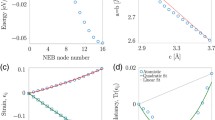Abstract
After a survey the refined numerical treatment and verification is presented for a rate-independent macroscopic unified PT material model (including mass conservation with respect to phase fractions and covexified free energy) by Govindjee and Miehe (Comput Methods Appl Mech Eng 191:215–238, 2001) for describing SME and SE effects within a linear kinematic setting. Special attention is given to temperature dependent PTs. The material model was implemented into ABAQUS via the UMAT material interface in 2004. Validation of this PT model is carried out with experimental data supplied by Xiangyang et al. (J Mech Phys Solids 48:2163–2182, 2000), using 3D finite element computations. Experimentally gained material data from different sources are used and numerical results of energy barriers for PTs are given. Another feature is the simulation of suppressed shape memory effects by quasiplastic temperature induced PT. Furthermore, a plane strain problem is treated with comparisons of butterfly shaped expansions of martensitic PT and plastic deformation, correspondingly.
Similar content being viewed by others
References
Ball JM, James RD (1987) Fine phase mixtures and minimizers of energy. Arch Rat Mech Anal 100:13–52
Bhattacharya K (2003) Microstructure of martensite : why it forms and how it gives rise to the shape-memory effect. Oxford University Press, Oxford
Carstensen C (2005) Ten remarks on nonconvex minimisation for phase transition simulations. Comput Methods Appl Mech Engrg 194:169–193
Govindjee S, Miehe C (2001) A multi-variant martensitic phase transformation model: formulation and numerical implementation. Comput Methods Appl Mech Engrg 191:215–238
Govindjee S, Mielke A, Hall GJ (2003) The free-energy of mixing for n-variant martensitic phase transformations using qausi-convex analysis. J Mech Phys Solids 52:I–XXVI
Hall GJ, Govindjee S (2002) Application of the relaxed free energy of mixing to problems in shape memory alloy simulation. J Intell Material Syst Struct 13:773–782
Howard G, Shield TW (1995) Orientation dependence of the pseudoelastic behavior of single crystals of Cu–Al–Ni in tension. J Mech Phys Solids 43:869–895
Levitas VI, Idesman AV, Stein E (1998) Finite element simulation of martensitic phase transitions in elastoplastic materials. Int J Solids Struct 35:855–887
Mielke A, Theil F, Levitas VI (2002) A variational formulation of rate-independent phase transformations using extremum principle. Arch Rational Mech Anal 162:137–177
Patoor E, Eberhardt A, Berveiller M (1995) Micromechanical modelling of superelasticity in shape memory alloys. J Phys IV C8-5:277–292
Stein E (ed) (2003) Error-controlled adaptive finite elements in solid mechanics. Chichester [u.a]: Wiley, New York
Uebel A (2002) Untersuchung des thermischen und Mechanischen Hystereseverhaltens von einkristallinen Cu82Al14Ni4-Formgedächtnislegierungen. Dissertation an der Fakultät III - Prozesswissenschaften der Universität Berlin
Winzek B (2000) Entwicklung, Herstellung und Charakterisierung von Mikroaktoren mit Formgedaechtnisschichten auf der Basis von TiNi. Dr.-Ing. thesis at Institut fuer Materialforschung, Programm Mikrosystemtechnik, Forschungszentrum Karlsruhe GmbH, Wissenschaftliche Berichte FZKA 6467
Xiangyang Z, Qingping S, Shouwen Y (2000) A non-invariant plane model for the interface in cualni single crystal shape memory alloys. J Mech Phy Solids 48:2163–2182
Author information
Authors and Affiliations
Corresponding author
Rights and permissions
About this article
Cite this article
Stein, E., Zwickert, O. Theory and finite element computations of a unified cyclic phase transformation model for monocrystalline materials at small strains. Comput Mech 40, 429–445 (2007). https://doi.org/10.1007/s00466-006-0118-x
Received:
Accepted:
Published:
Issue Date:
DOI: https://doi.org/10.1007/s00466-006-0118-x




